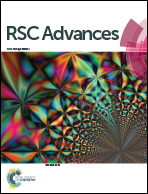Hierarchical porous graphitic carbon for high-performance supercapacitors at high temperature†
Abstract
Developing supercapacitors with high energy density without sacrificing the power density and cycle life has attracted enormous attention. Hierarchical porous graphitic carbons (HPGCs) have been demonstrated to be promising candidates. However, the complicated, energy-intensive synthesis and the difficult post-treatment for the reported synthetic HPGCs have confined the potential for large-scale production and practical applications. In this work, HPGCs have been fabricated by a one-step metallothermic reaction, using magnesium, urea, and zinc acetate dehydrate, showing a distinct hierarchical porous structure with graphitic domains. The assembled supercapacitors exhibit excellent performance at 150 °C, resulting in an energy density of 16 W h kg−1 (with a power density of 500 W kg−1). Moreover, the HPGC shows a high cycling stability (5% loss after 30 000 cycles), and ultrahigh capacitance retention, i.e. 70% at 5 A g−1 and 62% at 10 A g−1 using EMIMBF4 electrolyte, and 70% at 400 mV s−1 and 77% at 20 A g−1 using 6 mol L−1 KOH electrolyte. Most importantly, the universality of this new metallothermic method of HPGC fabrication has been demonstrated by replacing urea with other chemical substances. Such a facile synthesis may have provided a fresh route to produce HPGCs with excellent supercapacitive performance.



 Please wait while we load your content...
Please wait while we load your content...